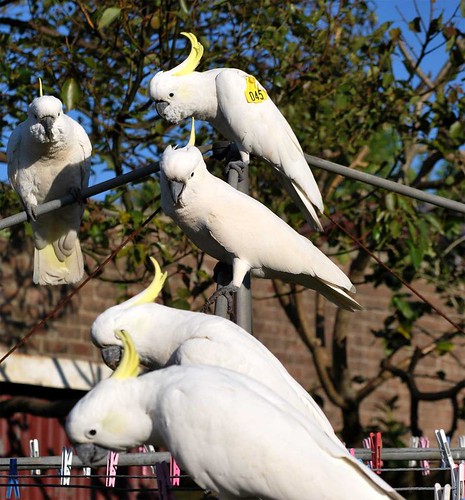 Who says the old Hills Hoist has gone out of fashion?- Yoda doesn't think so! (Photo: M Petrie, Chatswood)Columbus (01) prefers Mosman, while Pina Colada (05) is a regular on the balconies of Potts Point. A true north shore type, Burt (09), has never been spotted south of the bridge.
Who says the old Hills Hoist has gone out of fashion?- Yoda doesn't think so! (Photo: M Petrie, Chatswood)Columbus (01) prefers Mosman, while Pina Colada (05) is a regular on the balconies of Potts Point. A true north shore type, Burt (09), has never been spotted south of the bridge.
As for Party Boy (027), he spends most of his time between the botanic gardens and Kirribilli, photo bombing pictures of the Harbour Bridge and the Opera House.
''Party Boy is a favourite with a lot of people,'' says wildlife officer John Martin from the Royal Botanic Gardens.
''He's a bit like a supermodel,'' he says.
Over the past 18 months, public spotters have helped scientists understand the movements of the sulphur-crested cockatoo.
This week, the Cockatoo Wingtag study, run by the gardens and the University of Sydney, launched a fund-raising campaign to carry out the project's second phase. The team want to expand the number of observations and use GPS trackers to monitor the birds' movements in real time.
In five days, the public donated almost $3000, putting the team close to their initial $5000 target to develop an Android app to compliment their existing iPhone app.
So far, public spotters have recorded more than 5000 sightings of 70 tagged cockatoos as they moved throughout the city.
Bird enthusiasts can also monitor the project's Facebook page or iPhone app for a summary of the last 50 resightings.
''Now we have this nice picture of their urban foraging behaviour and city movements,'' said Mr Martin.
The team hope to raise $30,000 to buy 10 GPS trackers that can be fitted to the birds for up to a year. This data will give them an insight into how the birds interact with their natural habitat in the city's parks.
Most of sightings have been reported within five kilometres of the botanic gardens, and a few birds had been spotted more than 30 kilometres away.
''We want to know, is this urban foraging behaviour being used instead of natural foraging or in conjunction with,'' Mr Martin said.
The environment minister, Robyn Parker, who helped launch the campaign said while cockatoos were well known Sydney residents, little was known about their distribution. The species only began frequenting the city 50 years ago.
''This ecological study will tell us important facts about the size of the population and how they have adapted to city life and being in close proximity to humans,'' she said.